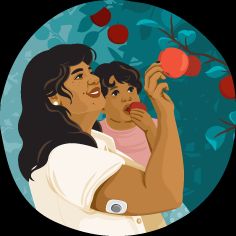Burning more calories can help you lose and maintain a healthy weight.
Exercising and eating the right foods are two effective ways to do this — but you can also boost the number of calories you burn in more unusual ways.
Here are 6 unconventional ways to burn calories.
Exposure to cold temperatures may help boost your metabolic rate by stimulating brown fat activity in your body (
While your fat stores are mainly made up of white fat, they also include small amounts of brown fat. These two types of body fat have different functions.
White fat’s main function is energy storage. Having too much white fat tissue may promote inflammation and insulin resistance.
In contrast, the main function of brown fat is to maintain body heat during cold exposure (
Brown fat’s calorie-burning effect has been shown to vary among individuals. In general, people who are obese seem to have less active brown fat than normal-weight people (
Based on early animal research, chronic exposure to cold is believed to lead to the browning of white fat — though this is still being studied (
Human studies indicate that exposure to cold temperatures may significantly increase calorie burning, depending on the amount of active brown fat in your body (
What’s more, you don’t need to endure freezing temperatures to reap this benefit.
In one study, healthy young men with similar body compositions stayed in a 66°F (19°C) environment for 2 hours. Though calorie burning increased in all of them, the effect was tripled in those with the highest brown fat activity (
In another study in 10 lean, young men, exposure to a temperature of 62°F (17°C) for 2 hours led to an additional 164 calories burned per day, on average (
A few ways to obtain the benefits of cold exposure include slightly lowering the temperature in your home, taking cold showers, and walking outside in cold weather.
SUMMARY Exposure to cold temperatures has been shown to stimulate brown fat activity, which increases the number of calories you burn.
Water is the best beverage for quenching thirst and staying hydrated.
Drinking water has also been shown to temporarily boost metabolism in normal and overweight adults and children. Some studies even suggest that you may be able to maximize this effect by drinking cold water (
One group of researchers reported that 40% of this increase in metabolic rate is a result of your body warming up the water to body temperature (
Two studies in young adults found that drinking 17 ounces (500 ml) of cold water increased calorie burning by 24–30% for 90 minutes (
However, the study was fairly small, and additional research suggests that water’s effect on metabolic rate may vary from person to person.
For instance, another study in healthy young adults noted that drinking 17 ounces (500 ml) of cold water increased calorie expenditure by only 4.5% for 60 minutes (
SUMMARY Drinking cold water has been shown to temporarily boost calorie burning. Still, the strength of this effect may vary by individual.
Chewing gum has been shown to promote feelings of fullness and reduce calorie intake during snacking (
Some evidence suggests that it may also help speed up your metabolism (19,
In a small study, normal-weight men consumed meals on four separate occasions. They burned significantly more calories following meals after which they chewed gum (
In another study in 30 young adults, chewing gum for 20 minutes after each meal increased metabolic rate, compared to not chewing gum. In addition, the rate remained higher after an overnight fast (
If you want to give this method a try, make sure to choose sugar-free gum to protect the health of your teeth.
SUMMARY Gum appears to increase metabolic rate when chewed after or between meals. Be sure to choose sugar-free gum to protect your teeth.
Having your blood drawn increases the number of calories you burn, at least temporarily.
When you donate blood, your body uses energy to synthesize new proteins, red blood cells, and other blood components to replace what has been lost.
Of course, donating blood isn’t something you can do every day. In general, you need to wait at least eight weeks between blood draws to replenish your blood supply.
Also, research suggests that donating blood may offer several health benefits, including lowering inflammatory markers, increasing antioxidant activity, and reducing your risk of heart disease (
Most importantly, whenever you donate blood, you’re potentially saving lives.
SUMMARY In addition to helping save lives, donating blood temporarily increases the number of calories you burn and provides other health benefits.
Exercising burns calories and helps you stay fit.
However, more subtle forms of physical activity can also boost your metabolic rate. This concept is known as non-exercise activity thermogenesis (NEAT), which includes fidgeting (
Fidgeting involves moving body parts in a restless manner, such as repeatedly bouncing a leg, tapping fingers on a table, and playing with rings.
In one study, people who fidgeted while seated or standing were shown to burn five to six times more calories, on average, than when they sat or stood still (
Another study found that people with the highest body weight experienced the greatest increase in metabolic rate in response to fidgeting and other types of non-exercise activity (
In some cases, NEAT can make a significant contribution to the number of calories you burn each day.
For instance, one group of researchers suggested that a combination of fidgeting, walking, and standing could burn up to 2,000 additional calories daily — depending on a person’s weight and activity level (
Because fidgeting may help you burn calories and prevent weight gain, some experts are calling for people to incorporate fidgeting and other forms of non-exercise activity into their daily lives (
Other ways to benefit from NEAT include taking the stairs, using a standing desk, and cleaning.
SUMMARY Fidgeting has been shown to increase the number of calories burned while sitting and standing, especially in those who are overweight.
It’s often said that laughter is the best medicine.
Indeed, research has confirmed that laughter may improve many aspects of mental and physical health, including memory, immunity, and arterial function (
What’s more, laughing also burns calories.
In one study, 45 couples watched movies that were either humorous or serious. When they laughed during the funny movies, their metabolic rate increased by 10–20% (
Although this isn’t very much, laughing on a regular basis is still a great way to improve your overall health and make you happier.
SUMMARY Studies suggest that laughing causes a slight increase in metabolic rate. Plus, it may improve your overall health and increase your quality of life.
Your metabolic rate determines the number of calories you burn each day.
Numerous factors affect your metabolic rate. By making simple lifestyle changes, you could increase your rate, helping you burn more calories and lose weight.
These include fidgeting, drinking plenty of cold water, laughing more often, chewing gum, and donating blood.
While the effectiveness of these weight loss strategies may seem insubstantial, they could make a difference in the long run.







